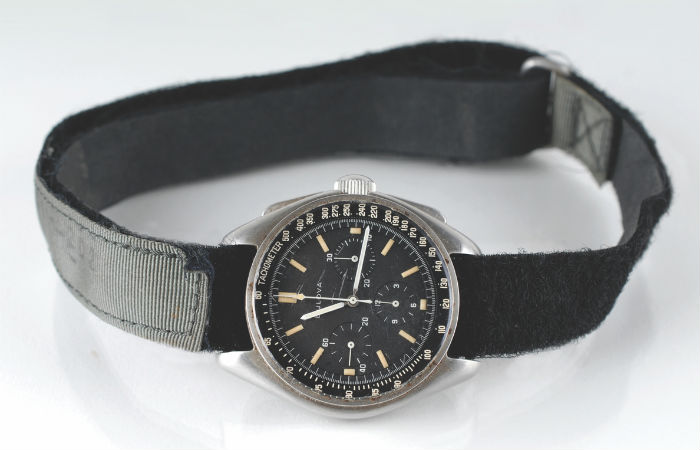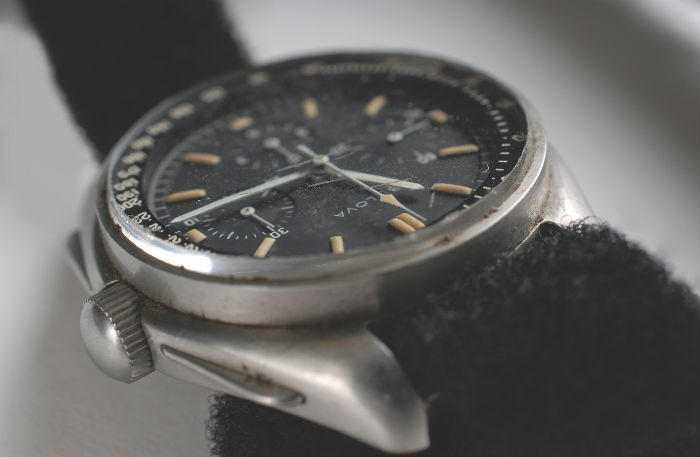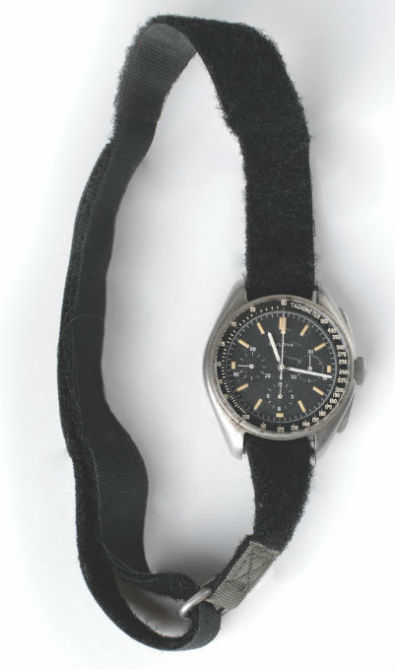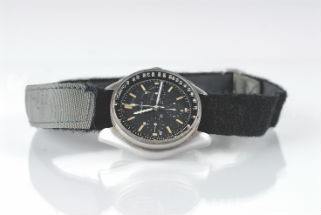
During the summer, when auction schedules slow down, The Hot Bid showcases world auction records.
What you see: The Bulova chronograph that astronaut David Scott wore on the surface of the moon during the Apollo 15 mission. RR Auction sold it in October 2015 for $1.6 million against an estimate of $750,000. It set a then-record for an Apollo item, a record for an item owned and directly consigned by an astronaut, a record for a timepiece used on the lunar surface, a record for any Bulova watch, and a RR Auction house record for the most expensive lot that it has handled.
The expert: Bobby Livingston, executive vice president at RR Auction.
The Apollo astronauts relied on government-issued Omega Speedmaster chronographs. How did Scott convince NASA to let him use the Bulova instead? He didn’t. Scott and the others are engineers, responsible for the lives of their crews. They brought backups. Bulova gave him the watch and a stopwatch, which we also sold. The company was U.S.-owned at the time. They tried very hard to get the chronograph contract from NASA. Bulova’s then-boss, Omar Bradley, had said, “How can we put boys on the moon wearing foreign-made watches?” During the second EVA [A NASA acronym that stands for “extravehicular activity,” which describes anything an astronaut does outside a spacecraft that has left the Earth], he noticed that the crystal on his Omega Speedmaster was gone. We don’t know why [it went missing] but the heat emanating from the sun may have heated to a temperature that had it pop off. Scott took the Omega off the strap and replaced it with the Bulova. It was a prototype watch. He brought it as a backup, with no promises to the Bulova company that he would use it.
The Bulova was a prototype? It was the prototype they made to pitch to NASA on the contract that Omega got. They developed it to go to the moon, but it was never put into production. Only Dave, the [spacecraft] commander, had a Bulova backup. I don’t think the others [his two crewmates] were approached by the Bulova company.
Could you talk for a bit about why the astronauts needed these watches, and how they relied on them? They all needed wristwatches. Dave basically used it to keep track of the elapsed time on the consumables used. We included a quote from Scott in the catalog: “Time is of the essence during human lunar expeditions – and exploration time on the surface is limited by the oxygen and water (for cooling) we can carry in our backpacks … knowledge of precise time remaining was essential.”
How long did Scott wear the Bulova on the lunar surface? The third EVA was four hours, 49 minutes, and 50 seconds. [Livingston relayed these numbers from memory, with complete fluency.] What was really cool about the watch was he drove the lunar rover while wearing it. He was the first to drive on the moon, and the watch stood up to that, obviously. It was very much exposed to lunar material. You can see the scratches on the bezel.
Was Scott wearing the watch when he repeated Galileo’s experiment on the lunar surface, dropping the hammer and the feather and proving they’d hit the ground at the same time? Yes, but he didn’t actually use the watch. Each arm was holding out an item, and he didn’t need the timer to see them hit the surface. They hit at the same time. It was apparent. [Laughs] But he wore the watch when he did it. The significance of this particular watch on his arm when he did it was profound to us.
Did the watch and the strap have lunar dust on it? It certainly had remnants of lunar material when I saw it, and obvious damage to the crystal from the lunar surface.
The strap as well? Yes, it was apparent that lunar material was on it when I got it. There are shots of Dave wearing the watch during splashdown [the term for when a spacecraft makes its return landing in the ocean; the astronauts disembark into a dinghy], so it may have been in the ocean. [RR Auction created a dedicated catalog for Scott’s Bulova. You can see a period photo of a post-splashdown Scott, his watch clearly visible on his wrist, on pages 14-15.] There is a bit of rust on the watch. I saw lunar dust on it. It wasn’t covered. There wasn’t tons of it. But it certainly had it.

What did Scott do with the watch after the Apollo 15 mission? He put it into a baggie and kept it in storage for 40 years until he sent it to us.
Does the watch have inherent value? Would it be worth something even if it hadn’t gone to the moon on Scott’s wrist? It sounds like it might, given that it was a prototype designed to win a NASA contract. Even if it never went to the moon, it has collectible value. Interestingly, when I approached Bulova and said I had Dave’s Bulova, which he wore on the moon, they didn’t believe me.
How did you convince Bulova of your claim? Dave had retained documents from Bulova. I had source material that didn’t exist in their archives of Omar Bradley talking about the watch and getting the contract. Then they believed me. [Laughs]
You set an estimate of $750,000. How did you come up with that number? We based it on other artifacts that we had sold for Dave Scott. We sold his rotational hand controller for a similar price, $610,000, and we sold his cuff checklist for $364,000. We felt it was the most important thing that he had in his collection. We recognized that it was the only watch that’s been on the lunar surface that you could own. The government still retains all of the Omega watches. Anything that’s been on the lunar surface has immense value because it’s critical to the mission. This certainly was.
I imagine there was cross-competition for this between watch collectors and space memorabilia collectors. That was exactly what happened. As it got higher, we had dueling collectors of Apollo [material] and watches. They understood the significance of the item. Not only was it on the surface, it was a watch. It crossed over, certainly.
Did you try it on? I did not. The lunar strap had to fit on the space suit, so it was quite long. I used gloves to handle it. I do own a Bulova chronograph replica because it is my favorite thing.

Do you wear the Bulova replica every day? Yeah! [laughs]
How did you convince Scott to consign the watch? We knew it existed. It was rumored in the collecting community that he wore it on the EVA. Once he became a client, it did take some effort for him to consign it, but he’s glad he did. It wasn’t the first thing out of storage. We built a relationship with him, and then he said, “I have this watch … ”
Does the watch still work? From the time I got it to the time I sold it, it had a little life in it. Somehow, it showed us it still worked. [Between Scott taking the scouting photos of the watch and Livingston receiving the watch, the hands advanced, but it’s not clear when they briefly winked to life.] I wouldn’t wind it. Usually with a watch, you clean it. This watch, you don’t want to clean it. It’s just too important.
What was the auction like? We sold it live at our gallery in Boston. All of us worked really hard on the auction. It was a really intense moment, adrenalin pumping. When we exceeded our client’s expectations, it was unbelievable. If I recall correctly, there were five initial bidders. The lot took eight or nine minutes.
Was Scott there in the sale room? No, but he was listening through a computer. We got his reaction at the time. He was very generous and kind to everyone who worked on the auction. He made it about our staff and the auction. I think he understood the importance of getting the object in the hands of a collector who will take care of it. I think that’s what he cares about.
Were you surprised that it sold for $1.6 million? You know, our expectations were $750,000. It was thrilling for it to get to a $1 million bid and keep going [laughs loudly]. That was unbelievable. It was an achievement for us. We don’t sell fine art. We don’t have Banksy shredding his work on our walls. [laughs]
Why will this piece stick in your memory? It crosses so many lines. It’s history. It was important to the mission. It’s a great story. There’s incredible photographic provenance [evidence]. It comes right from him. It tells so many stories of the mission. It has an emotional resonance with me on so many levels. And it went to the moon! And came back!
___
By SHEILA GIBSON STOODLEY
Sheila Gibson Stoodley is a journalist and the author of The Hot Bid, which features intriguing lots coming up at auction. Follow her on Twitter at @SGSwritereditor.
Text is copyright Sheila Gibson Stoodley. Images are courtesy of RR Auction.


